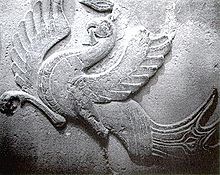Vermilion Bird
| Vermilion Bird | |||||||||||||||||||||||
|---|---|---|---|---|---|---|---|---|---|---|---|---|---|---|---|---|---|---|---|---|---|---|---|
 Zhūquè sculpture on an eaves tile | |||||||||||||||||||||||
| Chinese | 朱雀 | ||||||||||||||||||||||
| Literal meaning | "Vermilion Peafowl" | ||||||||||||||||||||||
| |||||||||||||||||||||||
The Vermilion Bird (Chinese: 朱雀; pinyin: Zhūquè) is one of the Four Symbols of the Chinese constellations. According to Wu Xing, the Taoist five elemental system, it represents the Fire element, the direction south, and the season of summer correspondingly. Thus it is sometimes called the Vermilion Bird of the South (Chinese: 南方朱雀, Nán Fāng Zhū Què). It is described as a red bird that resembles a pheasant with a fire-colored plumage and is perpetually covered in flames. It is known as Suzaku in Japanese, Jujak in Korean and Chu Tước in Vietnamese.
It is often mistaken for the Fenghuang due to similarities in appearance, but the two are different creatures.[1] The Fenghuang is a legendary ruler of birds who is associated with the Chinese Empress in the same way the dragon is associated with the Emperor, while the Vermilion Bird is a mythological spirit creature of the Chinese constellations.
Seven Mansions of the Vermilion Bird
[edit]As with the other three Symbols, there are seven astrological "Mansions" (positions of the Moon) within the Vermilion Bird. The names and determinative stars are:[2][3]
| Mansion no. | Name (pinyin) | Translation | Determinative star |
|---|---|---|---|
| 22 | 井 (Jǐng) | Well | μ Gem |
| 23 | 鬼 (Guǐ) | Ghost | θ Cnc |
| 24 | 柳 (Liǔ) | Willow | δ Hya |
| 25 | 星 (Xīng) | Star | α Hya |
| 26 | 張 (Zhāng) | Extended Net | υ¹ Hya |
| 27 | 翼 (Yì) | Wings | α Crt |
| 28 | 軫 (Zhěn) | Chariot | γ Crv |
Nature of the symbol
[edit]
The Vermilion Bird is elegant and noble in both appearance and behavior, with feathers in many different hues of vermilion. It is very selective about what it eats and where it perches.[citation needed]

Stars
[edit]See also
[edit]References
[edit]- ^ Strassberg, Richard (2002). A Chinese Bestiary. ISBN 978-0520218444.
- ^ "The Chinese Sky". International Dunhuang Project. Archived from the original on 4 November 2015. Retrieved 25 June 2011.
- ^ Sun, Xiaochun (1997). Helaine Selin (ed.). Encyclopaedia of the History of Science, Technology, and Medicine in Non-Western Cultures. Kluwer Academic Publishers. p. 517. ISBN 0-7923-4066-3. Retrieved 25 June 2011.
- ^ (in Chinese) AEEA (Activities of Exhibition and Education in Astronomy) 天文教育資訊網 2006 年 5 月 28 日
- ^ (in Chinese) AEEA (Activities of Exhibition and Education in Astronomy) 天文教育資訊網 2006 年 5 月 29 日
- ^ (in Chinese) AEEA (Activities of Exhibition and Education in Astronomy) 天文教育資訊網 2006 年 5 月 30 日
- ^ (in Chinese) AEEA (Activities of Exhibition and Education in Astronomy) 天文教育資訊網 2006 年 5 月 31 日
- ^ (in Chinese) 夢之大地 @ 國立成功大學 WebBBS DreamLand @ National Cheng Kung University WebBBS System
- ^ (in Chinese) AEEA (Activities of Exhibition and Education in Astronomy) 天文教育資訊網 2006 年 7 月 22 日
- ^ the star is actually located in the constellation Hydra
